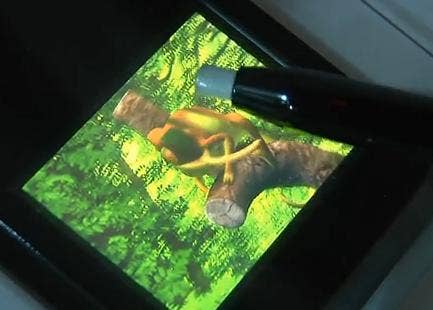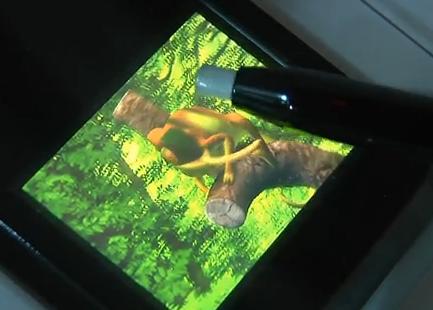Mobile 3D Display With Pen That Feels What You See (video)

Share
Japanese electronics firm NTT DoCoMo unveiled a cool new way to interact with the objects on your portable screen at the CEATEC conference this past week. The unnamed prototype device combines glassless 3D display with a physical feedback system that pushes on a magnetic pen. You hold the stylus pen near the display screen and when virtual objects want to reach out and touch you, you can feel it through forces on the pen. Haptic technology is already making its way into mobile phones with simple vibration responses. This new magnetic approach is another step towards revolutionizing how you control your phone, interact with digital information, or even play video games. Check out the NTT DoCoMo reps demonstrating the technology at CEATEC in the video below. A virtual lizard nearly licks the pen in someone's hand to make it jump. I love it.
Many of the 3D technologies we've seen in the past few years require viewers to wear glasses of some kind to get the 3D visual effect. NTT DoCoMo developed an alternate approach several years ago that uses virtual parallax - showing slightly different images depending on the angle from which you are viewing the screen. This produces a 3D effect without glasses to those who are viewing the display in person. In the video below, however, the display looks a little fuzzy as the camera is not able to pick up a stereoscopic view of the image from different angles:
NTT DoCoMo's prototype display doesn't just take an unusual approach to 3D, it also treats haptics in a new way. At the top of the device is a set of stereoscopic cameras that track the pen's position. Behind the 3D display is an inductive coil that can be pumped with electricity to create a magnetic field. The magnet buried in the stylus pen's tip is pushed by the coil when virtual objects need to interact with the user. As you can clearly see in the video below, the induction coil produces a pretty solid kick when powered up. It nearly knocks the pen out of the woman's hand, even after she expects it.
Be Part of the Future
Sign up to receive top stories about groundbreaking technologies and visionary thinkers from SingularityHub.


The prototype is strong then, but not terribly precise. That inductive push doesn't seem to have much (any?) directional control. To compensate, NTT DoCoMo may want to combine their magnetic approach with other haptics. Vibrations for mild touches, solenoids and inductive coils for hard pushes, and heat/cold for those sensations. We've already seen others pursue combined haptics for video games. For now, much of what you'll see on the market is going to be very simple. Most of the previous haptic technologies we've seen rely on vibrations, rather than actual pushing forces, to convey a sense of physicality to virtual objects. Vibrating controllers have been part of the video game scene since the late 90s, and vibrating phones are ubiquitous. These not so exciting forms of haptics are where we're at, and where we'll likely stay until developers like NTT DoCoMo can come up with useful alternatives that are also cheap and small enough to install in everything.
It's hard to know exactly what near term applications NTT DoCoMo will find for their mobile 3D haptic display. According to IDG News, representatives from the company at CEATEC stated that there were no definitive plans to develop the prototype into a marketable device. That's probably a good call. It's impressive that NTT DoCoMo can fit 'glassless' 3D display and haptics into a small mobile device, but these technologies probably aren't really ready for primetime. They should wait until after the 3D craze hits mainstream television, then portable versions will be more in demand. All in all, the protoype from NTT DoCoMo is very cool looking, but not something that we need at the moment. Give it a few years however, and similar systems will help us all poke and play with virtual creatures on our mobile phones. There's a new Tamagotchi fad in our future, I can just feel it.
[image credit: EnGadget]
[screen capture and video credits: Network World/IDG News]
[sources: PC World/IDG News]
Related Articles

This Light-Powered AI Chip Is 100x Faster Than a Top Nvidia GPU

How Scientists Are Growing Computers From Human Brain Cells—and Why They Want to Keep Doing It

These Brain Implants Are Smaller Than Cells and Can Be Injected Into Veins
What we’re reading

